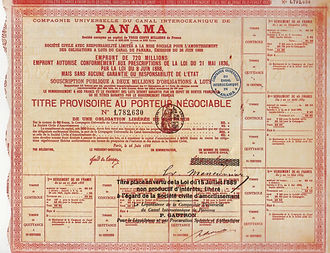Original French Canal Bonds
starting at $100

Painted Bonds
These paintings are the works of artists, using different techniques applied against the background of the stock and bond certificates issued by the [French] Compagnie Universelle du Canal Interocéanique de Panama, offered to investors during 1888-1889.
Painted Bonds from $300
Serigraphs from $100
Ask for our murals!
Bonos Pintados
Estas obras han sido pintadas por artistas, en diferentes técnicas, sobre los Bonos emitidos por la Compagnie Universelle du Canal Interocéanique de Panama y ofrecidos a los inversionistas entre 1888 y 1889.
Bonos pintados desde $300
Serigrafías desde $100
¡Pregunta por los murales!
Canal Bonds
Two million of these bonds, called “lottery bonds” to make them more attractive to potential purchasers, were issued. However, their sales were never successful, either in 1888 or in 1889. This failure led to the eventual collapse of La Compagnie Universelle du Canal Interocéanique de Panama.
Bonds from $300
Bonos del Canal
Se emitieron 2,000.000 llamados “bonos de lotería” para que fuesen más atractivos a los compradores potenciales. Sin embargo, su venta nunca fue exitosa; lo que condujo a la eventual quiebra de la Compagnie Universelle du Canal Interocéanique de Panama.
Bonos desde $ 300
The French Canal Shares and Bonds
From Pre-Columbian times, the Isthmus has been a place for human commercial and cultural exchange. Since its discovery in 1502 by Christopher Columbus, mankind has shown ever greater interest in the creation of a crossing between the Atlantic and the Pacific Oceans, a dream that began to be realized by the French attempt in 1880 to build a canal, which was finally brought to fruition in 1914 by the United States. During this interval, in 1903, Panama became independent from Colombia.
Ever since, life on the Canal has been intense, a whole “universe” passing through: ships and the people of every nation. The 1977 US/Panama Canal Treaties inaugurated a new era for the Canal with Panama finally obtaining full control of the Canal from the US on December 31, 1999.
Some twenty-five financial securities were issued over the years: by the Panama Rail Road Company, which built the first interoceanic railroad (1850 – 1880); and by the French canal companies, successively La Compagnie Universelle du Canal Interocéanique de Panama (1880-1889), La Société Internationale d´études du Canal Interocéanique de Panama (1889 – 1892) and La Compagnie Nouvelle du Canal de Panama, in 1894.
The painted bonds are those issued by La Compagnie Universelle du Canal Interocéanique de Panama and offered to investors during 1888 and again in 1889.
Two million of these bonds, called “lottery bonds” to make them more attractive to potential purchasers, were issued. However, their sales were never successful, either in 1888 or in 1889. This failure led to the eventual collapse of La Compagnie Universelle du Canal Interocéanique de Panama.
The bonds were printed in the manner usual in France at the end of the 19th century, on safety paper, with the respective watermarks and a wavy left margin.
They all bear the printed signatures of Ferdinand de Lesseps. They also usually bear a third signature, of a manager, and a fourth, that of an authorized agent. We may suppose that each bond lacking the fourth signature belongs to the group that could not be sold.
The Canal shares and bonds continue to have many stories to tell.
Los Bonos del Canal Francés
Desde la época precolombina el istmo ha sido un puente de intercambio humano, comercial y cultural, y desde su descubrimiento en 1502 por el Almirante Cristóbal Colon, tenemos noticia del interés creciente de los hombres por crear un paso acuático, el Canal, un sueño que comenzó en 1880 con los franceses y se concretó en 1914 con los norteamericanos. En ese lapso de tiempo, en 1903, Panamá se independiza de Colombia. Desde entonces la vida del canal transcurre con gran intensidad, todo un “universo” pasa por allí, barcos y hombres de todas las naciones; en 1977 con los tratados canaleros se anuncia una nueva era, que incia el 31 de diciembre de 1999.
Unos 25 títulos financieros fueron emitidos para el esfuerzo de construcción del primer ferrocarril interoceánico, por parte de la Panama Rail Road Company (1850 – 1880); los del canal, por parte de la Compagnie Universelle du Canal Interocéanique de Panama (1880 – 1889), de la Societe Internationale d´études du Canal Interocéanique de Panama (1889 – 1892) y de la Compagnie Nouvelle du Canal de Panama, en 1894.
Se emitieron 2,000.000 llamados “bonos de lotería” para que fuesen más atractivos a los compradores potenciales. Sin embargo, su venta nunca fue exitosa; lo que condujo a la eventual quiebra de la Compagnie Universelle du Canal Interocéanique de Panama.
Estos bonos están impresos en la tradicional manera francesa de finales del siglo XIX, en papel de seguridad, con sus respectivas marcas de agua y el margen lateral izquierdo ondulado.
Todos llevan las firmas pre impresas de Ferdinand de Lesseps y Charles de Lesseps. Por lo general tienen una tercera de un administrador, y una cuarta de un apoderado. Suponemos que cada bono sin la cuarta firma pertenece al grupo de bonos que no se puedieron vender.
Los bonos del canal tienen aun muchas historias que contar


